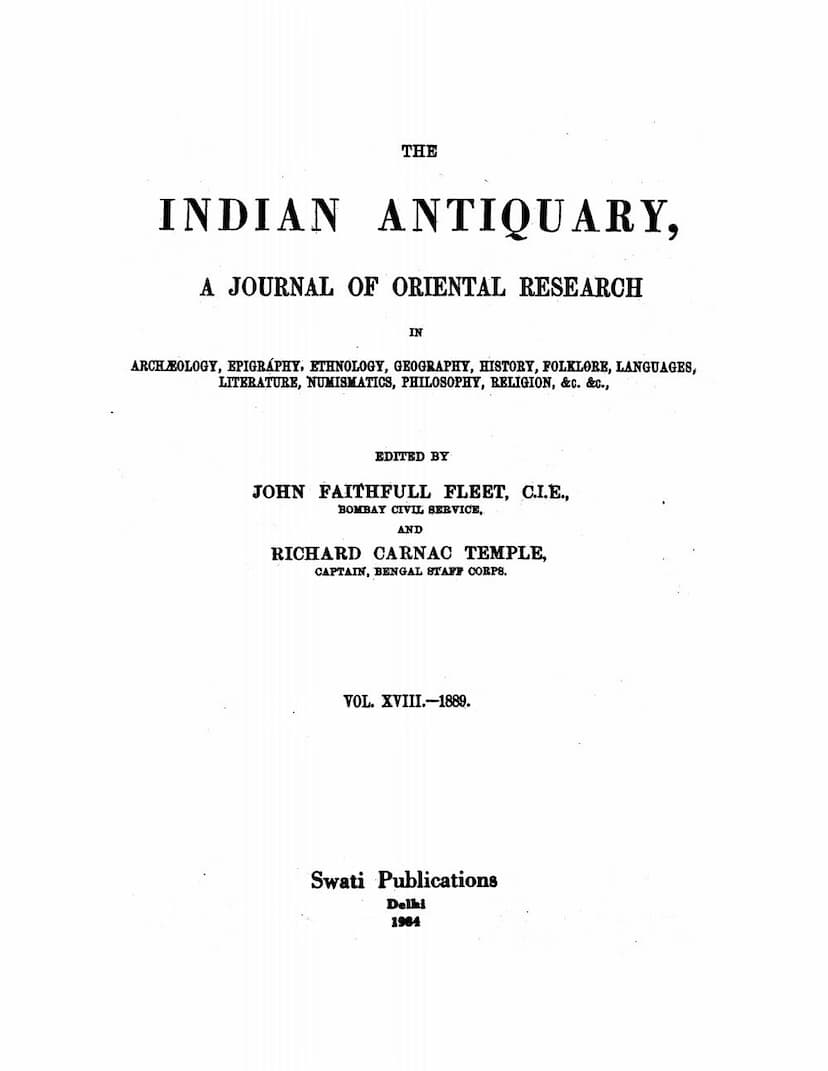Indian Antiquary Vol 18
Added to library: September 1, 2025

Summary
This is a comprehensive summary of the Jain content within the provided text, focusing on relevant sections of the Indian Antiquary, Volume 18, 1889:
Overall Publication Context:
- Title: Indian Antiquary, Vol. 18
- Editors: John Faithfull Fleet and Richard Carnac Temple
- Publisher: Swati Publications (reprint)
- Year of Original Publication: 1889
The Indian Antiquary is a journal of Oriental research covering a wide range of topics including archaeology, epigraphy, ethnology, history, religion, and literature. Volume 18, published in 1889, contains numerous articles by various contributors, focusing on Indian history, languages, and culture.
Jain Content Identified:
The provided text includes references to Jainism primarily through its epigraphy, specifically in the form of inscriptions. The following entries from the table of contents and the text itself highlight Jain-related content:
-
"SANSKRIT AND OLD-KANARESE INSCRIPTIONS: No. 173. Gudigere Jain Inscription; Saka-Samvat 998" by J. F. Fleet:
- This entry is directly about a Jain inscription.
- Key Information from the Text:
- The inscription is located at Gudigere, a town in the Dharwad District.
- It is engraved on a stone tablet, a fragment of which is extant.
- The characters are Old-Kanarese, typical of the 11th century AD.
- The language is Old-Kanarese, with two Sanskrit verses.
- The inscription mentions Jain religious figures and concepts:
- Srinandipanditadeva: Referred to with various epithets, including "Siriyanandimunindra" and "Siriśandi," described as an Acharya who had "crossed to the other shore the sea of nectar of the Siddhantas and all the other Sastras." He is also called "paravádi-sarabhabhérunda," indicating his skill in vanquishing opponents.
- Ashtôpavâsiganti (or Ashtôpavâsi-Kânti): Identified as a disciple (sishshinti) of Srinandipandita, who "delighted in the duty of maintaining the religion of Jinêndra."
- Pârsva-Jinêsvara: The object of worship for whom land was granted.
- Jina: Mentioned in relation to the religion of Jinêndra.
- Arhat: Referred to as the "divine Arhat," "omniscient one," and "destitute of passion (vita-rága)." The regal titles Paraméśvara and Paramabhattáraka are also applied to the Arhat in this inscription, which is noted as a "peculiar instance of borrowing from Hinduism."
- Jain temple: Mentioned as Ånêsejjeya-basadi, built by Kunkumamahâdevî.
- Gávundus: Village headmen who provided protection for the grants.
- Proprietary grants: The inscription records grants of land (mattars) given as "namasya-grant" (rent-free land) and "sarvanamasya-grant" for the purpose of providing food for saints and for the worship of Pârsva-Jinêsvara.
- Date: Saka-Samvat 998 (expired).
- Key Places: Gudigere (also referred to as Dhvajatâtaka in Sanskrit), Pullumgûr (modern Hulgur), Purigore (modern Lakshmeshwar).
-
Mentions within other Inscriptions: While the primary focus of the Indian Antiquary is broad, other inscriptions discussed may indirectly reference Jainism or figures associated with it through their patrons or the context of land grants. However, based on the provided text, the Gudigere inscription is the most direct and detailed reference to Jainism.
Summary of the Gudigere Jain Inscription:
The Gudigere Jain inscription, dated Saka-Samvat 998, is a significant find from the 11th century AD. It details land grants made for religious purposes, specifically for the worship of Pârsva-Jinêsvara and the provision of food for Jain saints. The inscription highlights the presence and influence of Jain religious figures like Srinandipandita and his disciple Ashtôpavâsiganti. It also reveals the administrative structure, mentioning officials like the Pergade Prabhâkara and the village headmen (Gávundas) who protected the grants. The inscription underscores the practice of rent-free land grants (namasya and sarvanamasya) and the integration of Jain religious figures and institutions into the local administrative and social fabric of the time. The use of both Sanskrit and Old-Kanarese languages, along with the specific terminology related to Jainism, makes this inscription a valuable source for understanding the religious and cultural landscape of that period in Southern India.
This summary focuses on the explicit Jain content within the provided snippets. If there are other sections within the full Vol. 18 that relate to Jainism, they would require a complete review of the volume.